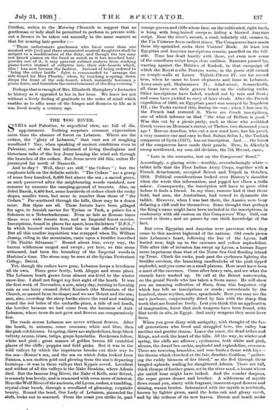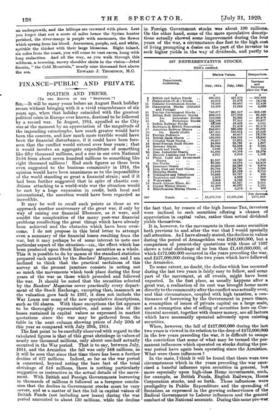THE DOG RIVER.
SYRIA and Palestine, to superficial view, are full of die. appointment. Nothing surprises common expectation more than the absence of forest on Lebanon. Where are the cedars, the " glory of Lebanon," that vast sea of soughing woodland ? Nay, when speaking of ancient conditions even in Palestine, one of the best informed of living theologians and historians talks of the boy Jesus hearing the wind sob through the branches of the cedars. But Jesus never did this, unless He journeyed far north of Nazareth.
And to-day ? Well, there are still " the Cedars " ; but the emphasis falls on the definite article. " The Cedars " are a group of some four hundred, 6,400 feet above the sea ; a sacred grove, as such preserved after the neighbouring woods vanished, now summer by summer the camping-ground of tourists. Also, on Jebel Baruk, 8,400 feet, some hundreds of cedars climb the rocky slopes, smaller trees, but more in number than those of " the Cedars." Far-scattered through the hills, there may be a dozen more. But these are all. These forests have been pillaged for ages, to furnish navies for Tyrian or Turk, a palace for a Solomon or a Nebuchadnezzar. Even so late as Roman times there were wide forests here, and an Imperial forest service. Inscriptions, found in places far apart, bore the letters " D.F.S.," in which learned writers found this or that official's initials. But all this erudite inquisition was scrapped when Dr. William Jessup, riding in the mountains, came upon a boulder inscribed "De Finitio Silvarum." Round about him, every way, the barren wilderness surged and swept ; yet here, as this stone witnessed, had been the boundary of the Imperial woods in Hadrian's time. The stone may be seen at the Syrian Protestant College, Beirut.
Yet, though the cedars have gone, Lebanon keeps a loveliness all its own. Pines grow freely, both Aleppo and stone pines. The Lebanon heath grows from almost sea-level to the winter snow-line. I shall not forget my first sight of the heath. It was the first week of November, a raw, misty day, turning to freezing rain as our lorry crossed Jebel Keniseh (the Mountain of the Church, so named from its shape) and we saw Beirut and the sea; saw, also, crowding the steep banks above the road and washing round the red boles of the umbrella-pines, a tide of red heath, the lovelier because we had come from the bareness of Anti- Lebanon, where trees do not grow and flowers are comparatively few.
The roads across Lebanon are never without flowers. After the heath, in autumn, come crocuses, white and blue, then the pink colchicums. In spring, there are asphodelines, large black velvety arum, irises, tulips, grape-hyacinths. Rockroses follow. white and pink ; great masses of golden broom fill crumbled places of the cliffs ; poppies and field pinks. But it was in the wild valleys by which the impetuous brooks cut their way to the sea—Homer's sea, and the sea on which John looked from Patmos, a sea molten gold and glowing from the sun's departing footsteps—it was in these valleys that Kypris roved. Loveliest and wildest of all the valleys is the Nahr Ibrahim, where Adonis died. But the famous Dog River, the Nahr el-Kelb, near Beirut, is scarcely less lovely, and is crammed with even more of interest. Here the Wolf River of the ancients, old Lyons, rushes, a tumbling, crystal-clear brook, through a woodland of gleaming, exquisite beauty. Round the bend, Our Lady of Lebanon, pinnacled far .aloft. looks out to seaward. From the coast you strike in, past
orange-groves and cliffs whose face, on the cultivated, right bank, is hung with long-haired creepers hiding a blurred Assyrian script. Near the river's mouth, a road, infinitely old, crosses it, the Via Victorum from earliest times. The Conquerors have made these lily-sprinkled rocks their Visitors' Book. At least ten Egyptian and Assyrian inscriptions remain, panelled on the hill- side. Time has dealt hardly with these, yet even now some of the cuneiform script keeps clear outlines. Rameses passed by, warring against the Hittites of Kadesh, in that campaign of which the Royal scribe Pentaur wrote, in the poem still extant on temple-walls at Luxor. Tiglath-Pilcser IV. cut his record here, when he came to hunt elephants and lions in Lebanon. Assur-nasir-pal, Shalmaneser II., Adad-nirari, Sennacherib, all these have set their graven boast on the enduring rocks. Other inscriptions have faded, washed out by rain and frost ; and some have yielded to envy of later rivals. After the French expedition of 1860, an Egyptian panel was usurped by Napoleon III. ; the Turks excised this, during the war ; when I last saw it, the French had restored it. There are Greek inscriptions, one of which informs us that " the wine of Helbon is good." Was this cut by a picnic-party, such as those who scribbled Greek verses on Memnon's statue, at Thebes, two thousand years ago ? Marcus Aurelius, who cut a new road here, has his panel, a very massive one and easy to find. Sultan Selim I., the Turkish conqueror of Syria (1517), has an inscription. And . . . the latest of the conquerors have made their panels. Here, in Allenby's sweep northward, my own old division, the 7th Meerut, came, " Late in the centuries, last up the Conquerors' Road."
Accordingly, a glaring white—terribly, overwhelmingly white— tablet tells that the First Indian Army Corps, together with a French detachment, occupied Beirut and Tripoli in October, 1918. Political considerations looked over History's shoulder when she wrote this information, and jogged her elbow a trifle askew. Consequently, the inscription will have to grow older before it finds a friend. In my time, rumour had it that those bold, bad men, the Australians, had vowed to dynamite the tablet. However, when I was last there, the Aussies were busy defacing a cliff-wall for themselves. Some thought that perhass the King's name might have been included in the inscriptions, in conformity with old custom on this Conquerors' Way. Still, our record is there ; and no passer-by can shirk knowledge of the fact.
But even Egyptian and Assyrian were parvenus when they came to this ancient highroad of the nations. Old roads pierce into Lebanon's heart, following the line of the Lycus, half buried now, high up in the crocuses and yellow asphodeline. Tide after tide of invasion has swept up Lycus, a human Eager more impetuous than that of the Norse Sea-God flooding inland up Trent. Climb the rocks, push past the cyclamen lighting the boulder-crevices, the branching candlesticks of the pink-tipped asphodel, and you come on a small plateau. Here must have been a mart of the cavemen. Come after heavy rain, and see what the runnels have washed up. Or call at the Beirut waterworks, on the genial Swede who has taken a Scots name. He will show you an amazing collection of flints, from this forgotten city which has left no inscriptions or roads ; arrowheads by the hundred, stone scythes, adzes, spearheads. Here you may see the ass's jawbone, conjecturally fitted by him with the sharp flint teeth that are found so freely. Lest you think this an application of imagination, know that such weapons have been found, with flint teeth in situ, in Egypt. And nasty weapons they must have been.
When you grow dizzy with antiquity, with thought of the far- off generations who lived and struggled here, the valley has another and gentler charm. Leave the coast, the dead tribes and Kings, and seek the heart of the hills. All the way, in winter and spring, the cliffs are afiower ; cyclamens, both white and pink, aliums, the dwarf bee-orchis, asphodel and asphodeline, crocuses.
There are towering brambles, and rose-bushes dense with hips— the thorns which clutched at the fair, desolate Goddess, " gather- ing the ruddy blossom of her blood," as she fled through these tangled uplands, wailing for slaughtered Adonis. There are tall, thick clumps of feather-grass, set in the river sand, a haunt where the caitiff boar might have lurked. And the wonder deepens, the copse grows denser and lovelier. A wilderness of myrtle flows round you, starry with fragrant, innocent-eyed flowers and
shining, waxen berries. Intermixed with the myrtle is terebinth, known by lighter green, amid the holm-oak and glossy carob, and by the redness of its new leaves. Broom and heath make an undergrowth, and the hilltops are crowned with pines. Lest you forget that not a score of miles hence the Syrian hunter perished, the river-marge is purple with anemones, the flower which sprang from his blood. Anemones, purplei red., and white, sprinkle the thicket with their large blossoms. Right inland, six miles from the coast, you will come to vast caves, hung with long stalactites. And all the way, as you walk through this wildness, a towering, snowy shoulder shuts in the vision-Jebel Sannin, " the Cold Mountain," nearly nine thousand feet above
the sea. EDWARD J. THOMPSON, M.O.



































 Previous page
Previous page